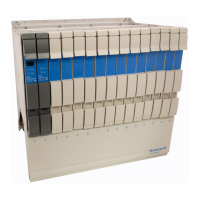4 Fault Isolation
4.9 HPMM Alphanumeric Display
360 HPM High-Performance Process Manager Service R688
Honeywell December 2020
Indicates that the HPMM has transitioned to the Fail state. If the Detailed-display
switch is not engaged after a failure is noted, the display continues to blink showing
the Ffnn. If the Detailed Display switch is engaged after a failure is noted, the display
alternates between the Communications processor and Control processor crash code
displays and the Fail state display as long as the failure condition permits the
Communications processor to maintain the display.
Refer to “Comm/Control Hard failure codes” subsection (“Fault Isolation” section) for
descriptions of the Communications and Control processor Hard failure codes.
Since the Communications and Control processor crash codes are not all unique to
the processors, they are preceded by a flag in the display sequence (COMM/CTRL).
For example, Fail state, COMM flag, Communications processor Hard failure code,
CTRL flag, Control processor Hard failure code, blank, Fail state, --pattern repeats.
Note that prior to successfully loading the HPMM, the Control processor is held
initialized. Therefore, only the code for the Communications Hard failure code is
significant. In this case the Control processor code would be null.
Indicates that the HPMM personalities for the Communications, Control, and I/O Link
processors have been loaded, and the HPMM has transitioned to the Idle state or has
been placed in the idle state from the Universal Station display.
Indicates that the HPMM has transitioned to the Idle Soft Fail state.
Indicates that the HPMM is currently in the process of down loading the HPMM
personality from the LCN. This display blinks at a 1/2 second rate to indicate the
Communications processor is still running.
Indicates the HPMM has transitioned to the Run state and is the primary HPMM. This
display does not blink.
Indicates that the HPMM has transitioned to the Run Soft Fail State. This display does
not blink.
Indicates that the HPM is performing its Cold or Ram Retention Startup processing.
This generic message does not blink, and it is only available when the HPMM
Diagnostic detailed-display mode (switch) is not enabled. Otherwise, (with the detailed
display mode enabled) this display scrolls through the test sequence numbers (i.e. T
xx) of the Cold or RAM Retention startup diagnostics.
This message is momentarily displayed by the primary HPMM while transitioning to
secondary status. This generic message does not blink, and it is only available when
the HPM alphanumeric detailed-display mode (switch) is not enabled. Otherwise (with
the detailed-display enabled), this display scrolls through the test sequence numbers
(i.e. Txx) of the RAM Retention startup diagnostics required to reach the Secondary
status.
Note that there is no visible delay while the secondary HPMM transitions to the
primary status.
This message is temporarily displayed by a Secondary HPMM while performing
database synchronization with the Primary HPMM. It indicates that the Personalities of
the High-Performance Comm/Control and High-Performance I/O Link cards have been
loaded into the secondary HPMM or that a Primary HPMM has successfully
transitioned to the non-synchronized Secondary status (See “B nn” above). This
display does not blink.

